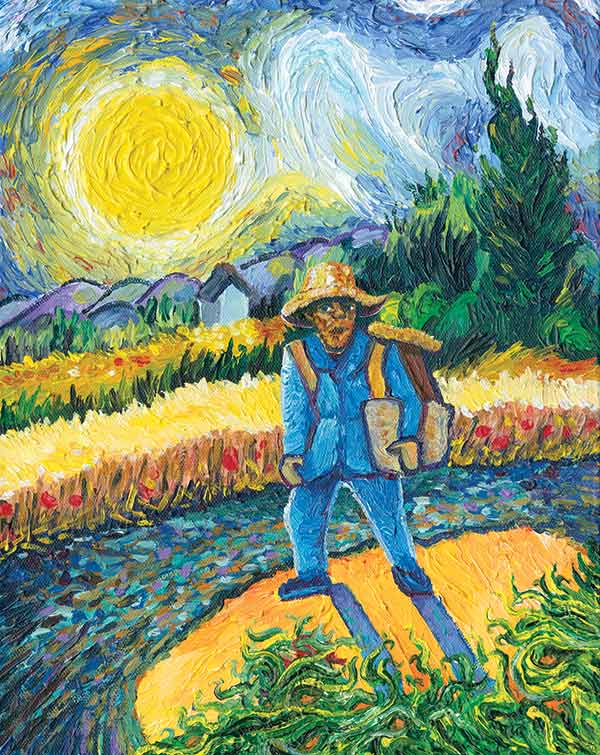Subtotal: $
Checkout-

All Things in Common?
-

The Sacrament of the Last Supper
-

Readers Respond Summer 2016
-

Serving Children in Pyongyang
-

Blessing out of Pain
-

Life Together: Beyond Sunday Religion and Social Activism
-

Solidarity
-

Possessions
-

Differences
-

Let Yourself Be Eaten
-

Repentance
-

At Table
-

Poem: Rainfall
-

From Property to Community
-

Why Community Is Dangerous
-

Confessing to One Another
-

The Way: Two Millennia of Christian Community
-

Friars of Manhattan
-

American Hospitality: Jubilee Partners
-

Live Like You Give a Damn
-

The Luxury of Being Surprised
-

The Incident in Changu’s Pepper Patch
-

Two Poems
-

Editors’ Picks Issue 9
-

The Jesus Indians of Ohio
-

Three Open Wounds
-

Why I Love to Wear a Head Covering

Next Article:
Explore Other Articles:
“I should one day like to show by my work what such an eccentric, such a nobody, has in his heart. That is my ambition, based less on resentment than on love in spite of everything, based more on a feeling of serenity than on passion. Though I am often in the depths of misery, there is still calmness, pure harmony, and music inside me. I see paintings or drawings in the poorest cottages, in the dirtiest corners. And my mind is driven towards these things with an irresistible momentum.” –Vincent van Gogh
Already a subscriber? Sign in
Try 3 months of unlimited access. Start your FREE TRIAL today. Cancel anytime.
From outdoor installations to film, music, and even themed hotel rooms, tributes to Vincent van Gogh’s art can be found everywhere these days. And no wonder. His aggressive brushstrokes, like those in his most recognized work, Starry Night, burst with a wild adrenaline and convey a lust for life. But who was van Gogh? In many ways, he was almost a caricature of the tortured artist. A social outcast who suffered from a long list of mental and physical ailments, some self-inflicted, he shot himself at the age of thirty-seven in a wheat field in Auvers, France.
Born in 1853 to a devout Christian family in the Netherlands, van Gogh was determined to follow in his father’s footsteps as a clergyman. Passionate to a fault, his efforts only led to failure and to rejection by the church establishment. However, his missionary work with impoverished coal miners left its mark and gave him a deep empathy for human suffering. At the age of twenty-seven he began to draw and paint seriously. His attempt to serve the church had failed – now he would preach with colors and brush.
Over eight hundred letters, written primarily to his brother and benefactor, Theo, convey van Gogh’s journey and development as a person and as an artist. Far from mere mad rantings, they reveal a depth and intelligence, a search for truth. Van Gogh wanted to create a new mode of art that could reach the soul. He wanted his viewers to absorb the explosive life force of the sun, to acknowledge the miraculous cycle of fertility in a freshly plowed field, to see heaven here on earth in the flight of the stars. “One cannot do better than hold on to the thought of God through everything, under all circumstances, at all places, at all times, and try to acquire more knowledge about him, which one can do from the Bible as well as from all other things. It is good to continue believing that everything is more miraculous than one can comprehend, for this is truth,” he wrote. “It is good to remain sensitive and humble and tender of heart.”

Jason Landsel, Forerunners: Vincent van Gogh
In his book The Power of Art, Simon Schama explains the artist’s mission to convey the miraculous: “Van Gogh yearned to make painting that was charged with the visionary radiance that had once been supplied by Christianity. Jesus, he wrote, was an artist whose medium had been humanity. Vincent wanted modern art to be a gospel, a bringer of light, that would comfort and redeem through ecstatic witness.”
Sadly, during van Gogh’s lifetime his color-soaked proclamations were mostly ignored; he sold only one of his approximately nine hundred paintings. “A great fire burns within me, but no one stops to warm themselves at it,” he lamented.
Though our culture encourages us to idolize fame and success, van Gogh’s story challenges us to consider a different path. He reminds us that in a life lived with passion for the gospel, weakness and failure are not the last word.
Already a subscriber? Sign in
Try 3 months of unlimited access. Start your FREE TRIAL today. Cancel anytime.






































John A Perazzo
Thank you. I never knew the faithful background of this artist. I am comforted.
Rosalind Siew
I am really touched. Thank you.